Palo Alto Prohibition: The Liquor Issue Comes Full Circle
Palo Alto owes its very existence to alcohol. Not as a place where you could get a drink, but rather as a place where you could not. Leland Stanford sought a “dry” town in the mid-1880s in which to center his university and Palo Alto was created in large part to serve that purpose. Throughout the city’s history, countless battles were fought over the liquor issue, as changing times and relaxed mores led to ever-increasing efforts to separate Palo Alto from its temperance past. These days, many Palo Altan bar hoppers would undoubtedly be surprised to learn that Downtown’s first legal cocktail wasn’t served until 1971.
Leland Stanford, Palo Alto’s premiere founding father, was a politician of his times. The former president of the Southern Pacific Railroad and governor of California, Stanford also served as U.S. senator from 1885 until his death in 1893. Many believed he harbored presidential ambitions in 1888 and 1892, he was
certainly in tune with the issues that dominated his political era --- including Prohibition.
The Prohibition movement to outlaw alcohol had been growing since the 1870s. First gaining traction in the South and then moving west, few politicians could be elected in the late 19th Century without at least publically supporting the cause. Of course, in Senator Stanford’s case, the irony was thick in the vineyards and wineries that he owned on the Peninsula and in Tehama County. But as a practical politician of his day, the senator was publically dry. So when Stanford wished to set up a local university, he looked for a town in which people could find “quiet homes where they could raise their children.”
Geographically, his first choice was Mayfield. In 1886, Stanford famously met with Mayfield town leaders to ask them to close down its dozen saloons and ban alcohol. Mayfielders responded with a definite no. So Stanford, in that tycoon style of the Gilded Age, bought his own town. In the coming years, Palo Alto
would thrive as a dry college city attracting families, professors, and temperance supporters. Mayfield remained as a wet alternative, and eventually wound up as Palo Alto’s poor relation. After annexation in 1925, it would be simply the southern section of an expanded Palo Alto.
Meanwhile, Palo Alto remained drier than ever. Originally, local prohibition had been written into law by Stanford trustee Timothy Hopkins in 1889. Based on Leland Stanford’s advice, Hopkins wrote land deeds stipulating that if liquor was ever sold on the property, the land (which would eventually become Palo Alto’s Downtown) would revert to the university. In 1909, the policy was further cemented as Palo Altan and State Senator Marshall Black helped persuade state legislators to adopt a law banning all intoxicating liquors within a mile and a half of the campus.
This early 20th Century push towards teetotalism was in step with national trends. In the 1910s the prohibition movement surged and by 1916, 23 states had banned saloons. In 1917, Congress passed the 18th Amendment to the Constitution, prohibiting “the manufacture, sale, or transportation of intoxicating liquors.” Two years later it was the law of the land.
But Prohibition proved to be impractical social policy --- difficult to enforce and extremely divisive. Gangsters and bootleggers ran wild transporting and selling illegal liquor while speak-easies and rule-bendingstills catered to the increasingly relaxed social attitudes of the Roaring 20s. After three years of Depression,
a reeling nation turned away from Stanford’s Herbert Hoover in the 1932 presidential election, as well as the Prohibition he had long supported. In December 1933, the nation’s change of heart was made official with the passage
of a 21st Amendment, overruling the 18th.
Of course, just because the federal government and the Constitution no longer prohibited alcohol, a local government could still ban it. In 1933, Palo Alto held firm when efforts were made to relax the restrictions to allow the sale of certain types of beer. It seemed that despite the national repeal of Prohibition, Palo Alto would go its own way.
But outside the city limits, things were different. That same year, a young lawyer named Frank Crist argued to overturn a deed restriction prohibiting the sale of alcohol in a small retail strip in what is now East Palo Alto. Soon the area became the home to liquor stores and bars that Stanford students nicknamed Whiskey Gulch.
By the 1950s, challenges were becoming more successful against Palo Alto’s booze ban. Slowly grocery store and restaurant owners began to nibble around the edges of the Palo Alto liquor law. In 1953, Robert Callavero was allowed to sell hard liquor at his store in South Palo Alto and a row of cocktail lounge restaurants sprouted up on El Camino Real. In the 1960s, some restaurants within the 1.5 mile loop around Stanford were allowed to sell drinks with low-alcohol contents while some odd arrangements pervaded --- the Palo Alto Club, for instance, allowed hard drinks as long as members brought their own bottles.
Finally, in 1970 Barry Amato, operator of a restaurant in the former Hotel President on University Avenue, successfully took the old Hopkins restrictions to court. Remarkably, his lawyer was Frank Crist, the man whose work way back in 1933 resulted in the establishment of Whiskey Gulch. Superior Court Judge Peter Anello ruled the old restrictions “invalid and unenforceable” and on May 22, 1971, attorneys Crist and Jack Kava posed for photographers toasting Downtown’s first legal public drink. It was later revealed that because the hard stuff arrived later, they were actually drinking water.
Economics played a large part in the more recent proliferation of bars and clubs in Palo Alto. Before then, Downtown remained largely empty at night without liquor licenses to entice the business of clubs and restaurants. Although there were initial fears after 1971 that some sort of Whiskey Gulch could take root Downtown, permits to sell liquor were eventually issued more liberally, as City Hall saw what a more vibrant nightlife could do for city coffers.
In the 1990s, the club and bar scene really took off and fancy restaurants brought out their best bottles of wine. As the liquor issue has come full circle as Palo Alto now boasts the most vibrant nightlife between San Jose and San Francisco. And as joyous revelers down Saki bombs at Miyake’s and stagger from Gordon
Biersch to the Empire Tap on Saturday nights, one wonders if the city founders aren’t doing a little spinning of their own. []
Our Reader's Memories:
"Harry's hamburgers in Whiskey Gulch... we spent lots of time enjoying their hamburgers which had a very special sauce (ketchup base with celery seed) ...would love the recipe if anyone has it. We would have some sauce put in a small dish and dip our fries in it. I have never forgotten their burgers. They would always give you a free burger if you went there on your birthday. They had a birthday club amd posted your picture on the wall. Their fries were especially delicious as they were double cooked. This was many years before McDonalds did it. A real gem of a place and always so happy to see you. This was in early 50s."
-Barbara
Send Us Your Memory!
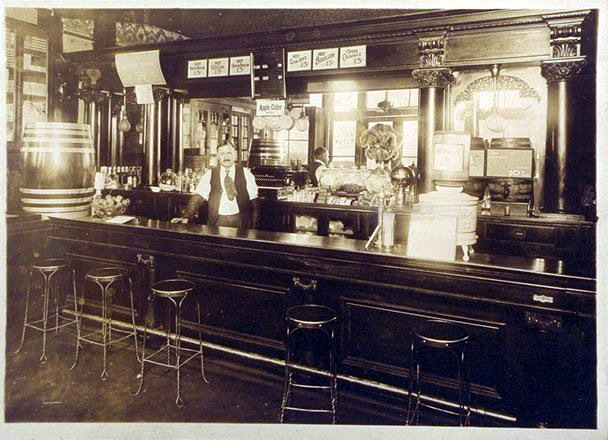
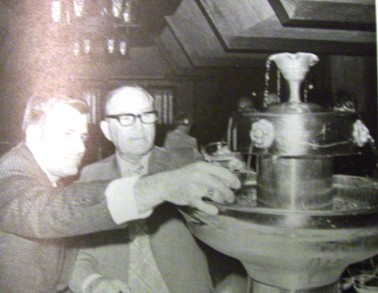
Jack Kava (Left) and Frank Crist (right) try out Downtown's first hard drink...or was it just water?
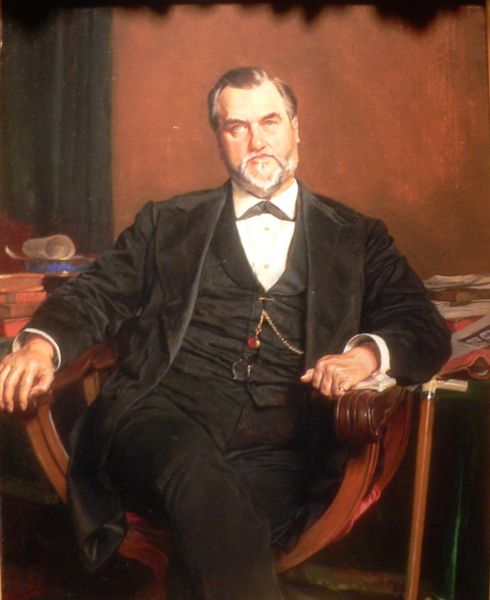
Leland Stanford, a baron of the Guilded Age.
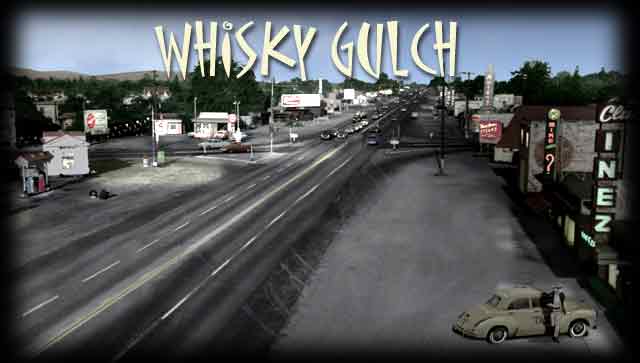
East Palo Alto's "Whisky Gulch" was a popular place to avoid Palo Alto's liquor laws.
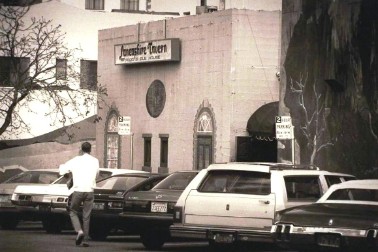
Lavenshire Tavern on Emerson Street in the 1970s. (PAHA)
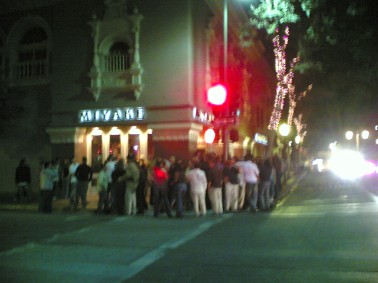
Sake bombers await their turn outside Miyake's on University Avenue.